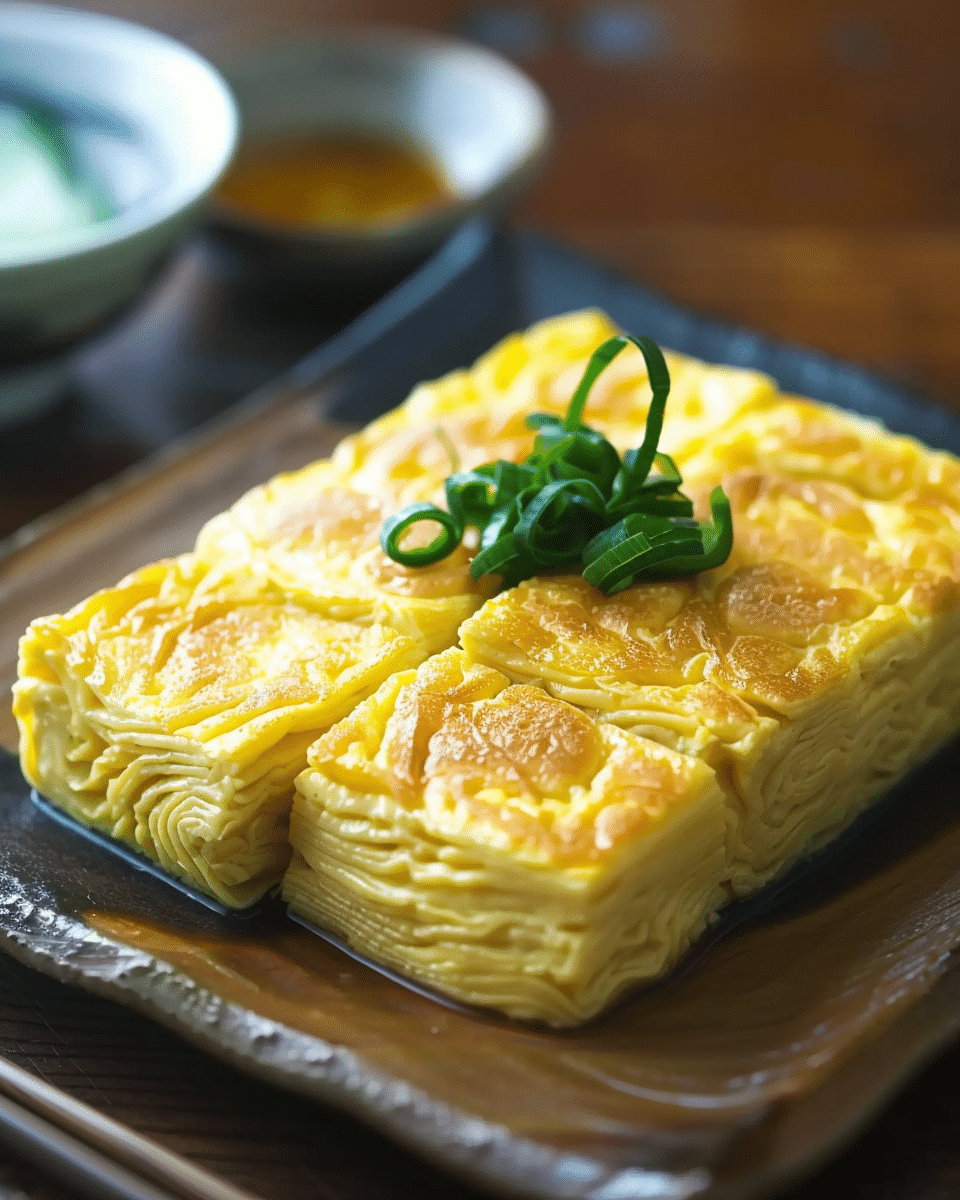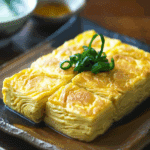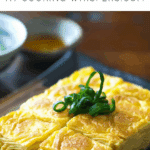
Why You’ll Love This Recipe
Tamagoyaki is not only delicious but also beautifully simple. The slightly sweet, savory flavor of the eggs is complemented by the tender, layered texture of the omelette. It’s perfect for those who want to try their hand at Japanese cooking without needing a long list of ingredients. The process of rolling the omelette gives it a satisfying, unique texture that makes it both fun to make and enjoyable to eat. Whether you’re serving it for breakfast, lunch, or as part of a bento box, Tamagoyaki adds a lovely, flavorful touch to any meal.
Ingredients
- 3 large eggs
- 1 tablespoon sugar
- 1 tablespoon soy sauce
(Tip: You’ll find the full list of ingredients and measurements in the recipe card below.)
Directions
- Prepare the Egg Mixture:
In a bowl, whisk together the eggs, sugar, and soy sauce until smooth and well combined. - Heat the Pan:
Heat a tamagoyaki pan (rectangular pan) or a small non-stick frying pan over medium heat. Lightly oil the pan using a paper towel or brush to prevent the eggs from sticking. - Cook the First Layer:
Pour a thin layer of the egg mixture into the pan, just enough to cover the bottom. Tilt the pan to spread it evenly. When the edges start to set but the top is still slightly runny, carefully roll the egg towards you using chopsticks or a spatula. - Add More Egg Mixture:
Push the rolled omelette back to the far end of the pan. Lightly oil the exposed part of the pan and pour in another thin layer of egg mixture, lifting the rolled omelette to allow the uncooked egg to flow underneath. When this layer is almost set, roll the omelette towards you again. Repeat this process until all the egg mixture is used up. - Shape and Serve:
Once the omelette is fully rolled, remove it from the pan and place it on a bamboo sushi mat or a cutting board. Let it rest for a few minutes to firm up. Slice it into bite-sized pieces and serve warm.
Servings and Timing
- Servings: 2-3 servings
- Total Time: 15 minutes
Variations
- Add Vegetables: You can add finely chopped vegetables like spinach, onions, or carrots to the egg mixture for added flavor and color.
- Add Fish or Meat: A small amount of cooked fish, like salmon, or shredded chicken can be added for a protein boost.
- Dashi Option: For a more authentic taste, add a teaspoon of dashi powder to the egg mixture for extra umami flavor.
Storage/Reheating
- Storage: Tamagoyaki is best enjoyed fresh, but it can be stored in an airtight container in the refrigerator for up to 2 days.
- Reheating: Reheat gently in the microwave for 20-30 seconds, or wrap in foil and warm it in a low oven to preserve its texture.
FAQs
How do I make the perfect roll with Tamagoyaki?
To make a smooth roll, make sure you pour a thin layer of egg at a time and wait for the edges to set before rolling. Use gentle, controlled movements when rolling to avoid tearing the omelette.
Can I use a regular round frying pan?
While a rectangular tamagoyaki pan is ideal, you can use a small, non-stick round frying pan as a substitute. The key is to keep the egg layer thin and ensure even cooking.
What can I serve Tamagoyaki with?
Tamagoyaki is often served with rice, miso soup, or as part of a bento box. It also pairs well with a side of pickled vegetables or steamed vegetables.
How can I prevent Tamagoyaki from sticking to the pan?
Make sure to lightly oil the pan between each layer of egg, and don’t let the pan get too hot. The eggs should be cooked over medium or low heat to prevent sticking.
Can I make Tamagoyaki ahead of time?
Yes, you can prepare Tamagoyaki ahead of time and refrigerate it. When ready to serve, simply slice it and serve cold or gently reheated.
Is Tamagoyaki gluten-free?
Yes, as long as the soy sauce you use is gluten-free. Some soy sauces contain wheat, so be sure to check the label if you need a gluten-free version.
How do I know when the eggs are done cooking?
The eggs should form soft, tender curds but should still be slightly moist. You want to avoid overcooking them, as they will become dry and rubbery.
Can I make Tamagoyaki without sugar?
You can omit the sugar if you prefer a more savory flavor. However, the sweetness balances the saltiness of the soy sauce, so it’s recommended for the traditional taste.
What’s the best way to store leftover Tamagoyaki?
Store leftover Tamagoyaki in an airtight container in the refrigerator for up to 2 days. Reheat it gently to keep the texture intact.
Can I use this method to make larger Tamagoyaki rolls?
Yes, you can increase the amount of eggs and use a larger pan, but you’ll need to adjust the size of the layers to keep the rolling process smooth.
Conclusion
Tamagoyaki is a simple yet elegant dish that brings a sweet and savory twist to your breakfast or lunch. With just three basic ingredients, it’s an easy-to-make, delicious option that’s perfect for busy mornings or when you want to impress with something a little different. Whether served in a bento box, alongside rice, or simply on its own, Tamagoyaki adds a touch of Japanese flair to any meal.

Japanese Tamagoyaki
- Total Time: 15 minutes
- Yield: 2-3 servings
- Diet: Gluten Free
Description
Tamagoyaki is a Japanese rolled omelette with a delicate balance of sweet and savory flavors, made with eggs, sugar, and soy sauce. It’s a simple yet elegant dish, perfect for breakfast or lunch.
Ingredients
3 large eggs
1 tablespoon sugar
1 tablespoon soy sauce
Instructions
- Prepare the Egg Mixture: In a bowl, whisk together the eggs, sugar, and soy sauce until smooth and well combined.
- Heat the Pan: Heat a tamagoyaki pan (rectangular pan) or a small non-stick frying pan over medium heat. Lightly oil the pan using a paper towel or brush to prevent the eggs from sticking.
- Cook the First Layer: Pour a thin layer of the egg mixture into the pan, just enough to cover the bottom. Tilt the pan to spread it evenly. When the edges start to set but the top is still slightly runny, carefully roll the egg towards you using chopsticks or a spatula.
- Add More Egg Mixture: Push the rolled omelette back to the far end of the pan. Lightly oil the exposed part of the pan and pour in another thin layer of egg mixture, lifting the rolled omelette to allow the uncooked egg to flow underneath. When this layer is almost set, roll the omelette towards you again. Repeat this process until all the egg mixture is used up.
- Shape and Serve: Once the omelette is fully rolled, remove it from the pan and place it on a bamboo sushi mat or a cutting board. Let it rest for a few minutes to firm up. Slice it into bite-sized pieces and serve warm.
Notes
Storage: Tamagoyaki is best enjoyed fresh but can be stored in an airtight container in the refrigerator for up to 2 days.
Reheating: Reheat gently in the microwave for 20-30 seconds, or wrap in foil and warm it in a low oven to preserve its texture.
Variations: Add finely chopped vegetables like spinach, onions, or carrots to the egg mixture for added flavor and color. For extra umami, add a teaspoon of dashi powder to the mixture.
- Prep Time: 5 minutes
- Cook Time: 10 minutes
- Category: Breakfast
- Method: Pan-frying
- Cuisine: Japanese
Nutrition
- Serving Size: 1 serving
- Calories: 140 kcal
- Sugar: 2g
- Sodium: 340mg
- Fat: 10g
- Saturated Fat: 2g
- Unsaturated Fat: 7g
- Trans Fat: 0g
- Carbohydrates: 4g
- Fiber: 0g
- Protein: 8g
- Cholesterol: 195mg







